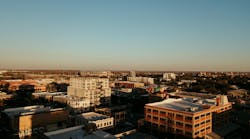Envirogen Technologies Inc. announced the successful startup and operation of a fluidized bed reactor (FBR) system to remove nitrates from contaminated groundwater at Kinder Morgan Energy Partners’ Mission Valley Terminal in San Diego. The 0.5 million gal per day (mgd) system is designed to provide a final treatment step for impacted groundwater pumped from an aquifer located beneath the city’s Qualcomm Stadium, prior to direct discharge to the watershed.
The Envirogen FBR system differs from conventional denitrification technology in that it does not create waste byproducts that require further treatment, the company said. Biological treatment is a more sustainable approach for addressing denitrification and can handle high levels of nitrates cost effectively.
“Our FBR technology differs from other denitrification processes in that it completely destroys nitrate, unlike phase transfer schemes, which generate waste byproducts requiring further treatment,” said Dr. Todd Webster, director of the Western Region for Envirogen. “While the FBR is an excellent ‘green’ treatment alternative, it is also a robust and cost-effective technology that can be designed into a very tight footprint and handle both low and high concentrations of nitrates. This made it the best solution to the full range of needs at this site.”
Envirogen’s FBR systems are fixed-film bioreactors in which sand or carbon media is suspended, or fluidized, within the reactor vessel by the upward flow of water through the system. The suspended media provides a large surface area for microbial growth and allows a biomass density several times greater than that of other bioreactor designs under similar loading conditions. Microorganisms in the reactor completely consume influent nitrates under anoxic conditions, reducing them to carbon dioxide, water, nitrogen gas and additional biomass growth.
The Mission Valley Terminal FBR installation, operated by Kinder Morgan, is designed to handle flow rates of 350 gpm from multiple wells and reduce influent nitrate levels of 4 mg/L to less than 1 mg/L nitrate. Envirogen Technologies provided system design and manufacture--including vessels, peripheral equipment, media and microbial innoculant--along with installation oversight and additional process control/integration support.
The system is largely self-regulating, requiring minimal operator attention and is capable of handling both hydraulic and organic shock loads. A chemical feed assembly automatically delivers a concentrated form of acetic acid as an electron donor to the system as required. The system effluent is sent through a post-aeration step to increase dissolved oxygen prior to discharge to Murphy Canyon Creek in accordance with a National Pollution and Discharge Elimination System permit.
Source: Envirogen Technologies

